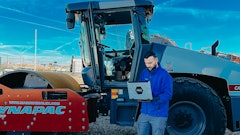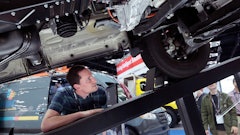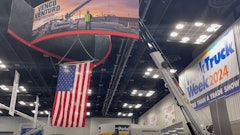
GPS and GNSS technologies have taken over the construction industry and for good reason. This technology is beneficial when it comes to safety, machine monitoring, and enhanced maintenance.
Most people are probably familiar with GPS since it’s the technology that people use to get to unfamiliar places. But just like GPS is the Global Positioning System, GNSS is the Global Navigation Satellite System. These two systems are quite similar and the only real difference is that GNSS provides equipment with a wider network of satellites.
Due to all of the benefits these systems have to offer, it’s no wonder that construction companies want their equipment to be equipped with one of them. The functions that each system brings help not only the construction workers but also the contractors, the companies, and the environment. But, what can companies do if they want their current equipment to have the technology?
Integrating Technology Aftermarket
Once a company has already purchased equipment, it may seem like there is no way to add anything to the technological aspect of the machines. But, there is a way to integrate GPS or GNSS technology into machines after purchasing them.
While getting the technology installed ahead of time is the ideal option, it isn’t the only way to get GPS technologies installed.
VP of the Heavy Construction Segment US/CAN at Leica Geosystems, part of Hexagon, Troy Dahlin described the more reliable and consistent optimization that can be provided as a result of getting technology factory-fit.
“Factory-fit machine control solutions offer a range of advantages, starting with seamless integration, optimized design, and more reliable and consistent performance through precise calibration and testing,” Dahlin said.
Although factory-fit solutions are optimal, GPS and GNSS technology can be installed well aftermarket. To get the most seamless incorporation, whether it be factory-fit or aftermarket, it is important that the OEM is being worked with.
Decisions to Make When Picking a GPS System
The options that come with having GPS systems installed are not as cut and dry as aftermarket vs factory-fit. There is also the question of what functions are needed.
“Many people default to location tracking when thinking of GPS, but GPS trackers can also deliver other telematic information including key operational and performance indicators that tell you how your machines are being used instead of just where they are,” said Ryan Lunar, director of sales east with Tenna.
Some things to consider when deciding on a system to integrate:
Models and forms
Operational and performance signals
System provider
Power source
Safety Capabilities
Using GPS or GNSS technology on equipment allows for a lot of safety features to be used. Added safety is provided to the workers and the machines.
Machines are better equipped and handled with perks like:
Maintenance detection — reduced downtime
Cost savings
AI video
Theft protection
Technology like AI video allows the system to detect and prevent potential safety hazards from happening. AI video can also help safety managers better understand certain events that they are alerted to like speeding and hard braking. Having a better understanding of safety events while operating heavy equipment can make safety policy reviews and new solutions to be placed. This technology keeps the machine protected and the workers safer.
Theft and GPS
Not only do GPS and GNSS increase safety for workers but they help prevent theft.
“Contractors can lose up to 10% of their fleet each year due to internal theft and misplacement, and even more due to external theft of construction equipment and tools,” explained Lunar.
Some of the theft-preventing features include:
Location notifications and alerts
Geofences
Can paired with AI safety camera solutions
Things like geofences and text alerts go hand in hand. The company or contractors could set geofences around the site so that if a machine was leaving the premises, they would get an alert letting them know that equipment is being taken off the site. In cases of theft, AI cameras can help handle any sort of ramifications and action.
Additional Benefits of Aftermarket GPS
If equipment in a fleet wasn’t equipped with GPS or GNSS originally, getting one of these systems installed is a great idea. These systems come with a great deal of benefits that include safety and easy alerts. Besides these advantages, there is a list of nice benefits that come with getting GPS technology installed in machines.
These additional advantages include:
Cost savings
Easy mileage monitoring
Location data accuracy
Efficiency
Automated regulation compliance
Access to hours-of-service data
Decreased rework
Easy employee work hours tracking
Real-time data communication
Adding GPS to Equipment
Once the decision has been made to incorporate GPS or GNSS technology into fleets, some basic steps need to be taken.
“Contractors should follow a systematic approach, starting with evaluating the current fleet and identifying the machines suitable for GNSS integration,” said Dahlin.
It is important to have realistic expectations when it comes to GPS and GNSS technology. Not every piece of equipment is going to be able to smoothly integrate with new technologies.
Lunar said, “The first step in ensuring successful GPS technology implementation is to have all appropriate parties involved in the conversation from the very beginning.”
Discussing the potential technological addition to machines with the OEM is extremely valuable and should be a first step when dealing with aftermarket GPS. It is also important to confirm that the current technology and necessary data formats on the machine are compatible with the chosen system.
Dahlin added, “It is crucial to engage certified professionals for the installation to guarantee precision and optimal performance.”
Open discussion during this process is vital for the entire operation. This sort of change affects a variety of departments and needs to be thoroughly discussed with the staff to improve efficiency and ensure a smoother integration process overall.
“Choosing a technology provider committed to an open architecture and future-agnostic technology is crucial when contemplating a long-term investment,” said Dahlin.
When deciding to incorporate GPS aftermarket, there is a lot to gain through making careful and smart decisions. While there are lots of things to consider, the most important thing is choosing what is best for the fleet or equipment now as well as in the future. It isn’t too late to improve machines and increase safety. If there is a fleet in need of an upgrade, GPS or GNSS incorporation could be that step forward needed to improve.





























